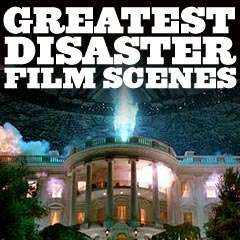
|
Film Scenes 1960s |

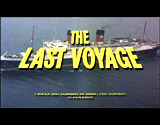
|
The Last Voyage (1960) Writer/director Andrew L. Stone's tense action/adventure film advertised "91 Minutes of the Most Intense Suspense in Motion Picture History!" It received only one Academy Award nomination for Best Visual Effects that it lost to The Time Machine (1960). The plot was about the SS Claridon, an aging luxury-liner in the Pacific on one of its last voyages, on its way to Tokyo. It suffered a devastating explosion and fire in its boiler room. The initial explosion, the flooding and destruction of the ship, and its dramatic sinking were effectively presented. The main suspense was provided by one family on board the doomed ocean liner, that became separated when trapped in the sinking ship:
In the thrilling ending, Laurie was saved just before drowning, with assistance from black crew member Hank Lawson (Woody Strode). In the film's last line, Cliff extended his hand to help Hank into a crowded lifeboat: "This is one guy I'm gonna help aboard personally!" As the ship completely disappeared under the water, the narrator added (off-screen): "This was the death of the steamship Claridon. This was her last voyage." |
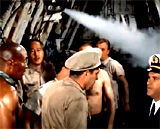  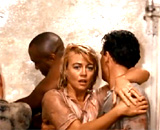 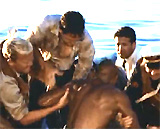
|
||||||||
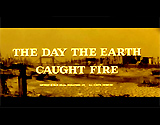
|
The Day the Earth Caught Fire (1961, UK) This UK apocalyptic disaster film was a speculative science-fiction opened with an orange-hued sequence in which Daily Express journalist Peter Stenning (Edward Judd) walked down a deserted street in the sweltering city of London. In flashback, the movie told about the Earth's orbit shifting when both the USA and the USSR exploded nuclear bombs at the same time, causing a shift in the Earth's position, and setting it on a course to slowly drift into the Sun. A new series of nuclear blasts (occurring in Siberia) were proposed to correct the problem - the film's ambiguous conclusion left the viewer hanging about Earth's survival. |
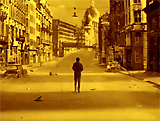
|
||||||||

|
Panic In Year Zero! (1962) (aka End of the World) Director/star Ray Milland's science fiction film was advertised with the tagline heralding the degradation of humanity: "'A'-Day...When Civilization Came to an End!" The plot told about the suburban Baldwin family:
They were on a camping trip in the nearby mountains (with a camper-trailer) witnessed a mushroom cloud explosion over LA - signaling a nuclear apocalypse. The resulting chaos included mass casualties, the struggle to survive from marauding gangs, lack of law and order, and radiation sickness. How far would family-man Harry Baldwin go to protect his family? |
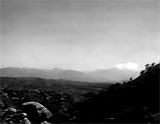 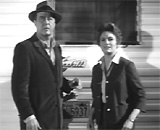
|
||||||||
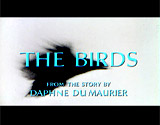
|
Alfred Hitchcock's thriller-masterpiece (his first film with Universal Studios) was a classic disaster film, and one of the first "animals attack" type of films. This Technicolor feature came after Psycho (1960) - another film filled with 'bird' references. Ub Iwerks was nominated for an Oscar for Best Achievement in Special Effects (the film's sole nomination), but lost to Cleopatra (1963). The film's technical wizardry was extraordinary, especially in the film's closing scene (a complex, trick composite shot). The film's non-existent musical score was replaced by an electronic soundtrack (including simulated bird cries and wing-flaps), with Hitchcock's favorite composer Bernard Herrmann serving as a sound consultant. The apocalyptic story was loosely based upon a short story by Daphne Du Maurier, and told about a northern California coastal town (Bodega Bay) filled with an onslaught of seemingly unexplained, arbitrary and chaotic attacks of ordinary birds - not birds of prey. The dark film hinted that the bird attacks were punishment for the failings of the relationships between the main characters. Hundreds of birds (gulls, ravens, and crows) were trained for use in some of the scenes, while mechanical birds and animations were employed for others, to simulate the massive bird attacks on a sleepy seaside town. |
 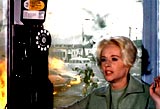 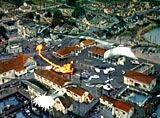
|
||||||||
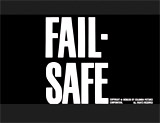
|
Fail-Safe (1964) Director Sidney Lumet's black and white, political doomsday disaster film during the Cold War era was about how World War III could actually happen. It was a serious and very bleak version of director Stanley Kubrick's black comedy Dr. Strangelove, Or: (1964). In this hypothetical film, misguided transmissions from Strategic Air Command (SAC) headquarters erroneously sent a squadron of US bombers with atomic weapons flying towards Moscow to attack. The tense 'race-against-time' was to try to beat the 'fail-safe' position when pilots would no longer have to follow orders. |

|
||||||||
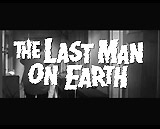
|
The Last Man on Earth (1964, It./US) (L'Ultimo Uomo Della Terra) The origination of this low-budget, dark Italian-made sci-fi disaster film was Richard Matheson's 1954 novel I Am Legend (and Matheson served as the film's co-scripter). The book was later the basis for two other important films:
Director George Romero claimed that the 1964 film was a major inspiration for his classic zombie film later in the decade, Night of the Living Dead (1968). The tagline for the film was: "Do you dare to imagine what it would be like to be... the last man on earth... or the last woman? Alive among the lifeless... alone among the crawling creatures of evil that make the night hideous with their inhuman craving!" Vincent Price starred as sole surviving, isolated and lonely scientist Dr. Robert Morgan - immune to a deadly epidemic-plague that spread throughout the land in 1965, three years earlier. In the film's first lines under the opening credits, he was mumbling to himself (in voice-over):
He was living in a nightmarish abandoned world as the 'last man on earth,' forced to slay the zombie-like, slow-moving, vampirish creatures that roamed the mostly-deserted environment. At one point, he became acquainted with another survivor named Ruth Collins (Franca Bettoia), whom he permanently healed with a vaccination-treatment. He vainly hoped she would join him in producing a new societal order. However, in the film's despairing conclusion with strong religious imagery and symbolism, Dr. Morgan (already wounded by gunfire) was surrounded on a church altar by a pursuing group of black-garbed, contaminated survivors (carrying spears and guns). As he called out to them to denounce them:
he was mortally impaled by a spear before they could be told by Ruth that he could save them. She rushed to his side, but it was too late. He died as he repeated to her three times: "They were afraid of me." She responded: "They didn't know." She slowly walked down the church's aisle and calmed a crying baby with false hope: "Don't cry. You have nothing to cry about. We're all safe now. All safe" - as the film's THE END appeared. |
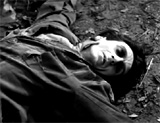    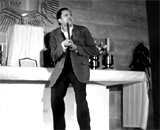 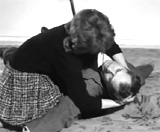 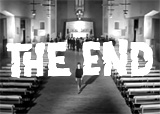
|
||||||||
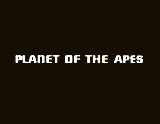
|
This was the first film in the franchise series of Planet of the Apes films. All of the films told about apes that had evolved into an intelligent society (with advanced make-up techniques) that reversed the social positions of intelligent humans and brutal apes to slyly criticize racial stereotypes. The classic films were derived from Pierre Boule's novel Monkey Planet, and also examined the effects of technology upon humankind. The film opened with the crash landing of a US spacecraft (launched in 1972) on a lake - on what was supposedly a strange, faraway planet. The surviving crew came upon evidence of civilization - however, to their surprise, it was characterized by advanced, talking civilized apes (who spoke English), with a reversal of social roles. The ape society appeared to be dominated by English-speaking simians who lived in a multi-layered civilization. Humans (who possessed few rights) had been reduced to primitive, subservient mute slaves and were even hunted for sport as animals. The three layers of society included gorillas (war-like enforcers, military, police, guards, hunters and common laborers), orangutans (gov't leaders, administrators, politicians, the ruling elite, lawyers and religious figures), and chimpanzees (the intellectuals, scientists and doctors); at the bottom were humans, considered feral animals (for experimentation and slave labor). In the film's startling conclusion, a post-apocalyptic, post-nuclear futuristic planet (Earth) (set in the year 3978 AD) was depicted, revealed in a view of a half-submerged Statue of Liberty. Stranded American astronaut George Taylor (Charlton Heston), having escaped from enslavement and imprisonment by the apes, rode on horseback down a beach shoreline into the Forbidden Zone with primitive human Nova (Linda Harrison) behind him. He suddenly stopped when he saw something, and dismounted to stare upwards. As the camera panned forward toward Taylor, through a spiked object, he exclaimed: "Oh, my God! I'm back. I'm home. All the time, it was..." He dropped to his knees: ""We finally really did it. You maniacs! You blew it up! Ah, damn you! Goddamn you all to hell!"
He pounded his fist into the sand and railed against Earth's generations almost 2,000 years earlier that had destroyed his home planet's civilization with a devastating nuclear war: "You maniacs! You blew it up! Ah, damn you! Goddamn you all to hell!" The full object came into view as the camera panned backward - the spiked crown of a battered Statue of Liberty buried waist-deep in beach sand. |
 "Ape City" 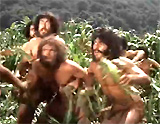 Primitive, Feral and Mute Native Humans in Cornfield 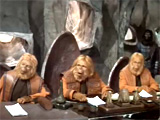 Orangutans -- Three Tribunal Judges 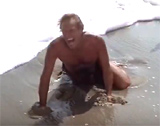 "We finally really did it. You maniacs! You blew it up! Ah, damn you! Goddamn you all to hell!" 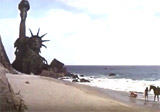 The Shocking Final Image |
||||||||

|
Krakatoa East of Java (1969) (aka Volcano) This disaster film by director Bernard Kowalski, advertised as "The Incredible Day That SHOOK the Earth to Its Core", was based on the most explosive volcanic eruption in recorded 19th century history - on August 27th, 1883, on the island of Krakatoa in the Netherlands East Indies. [Note: In actual fact, Krakatoa was located West of Java.] The film was nominated for one Academy Award: Best Special Visual Effects (it lost to Marooned (1969)). It was re-released in Europe in the mid-1970s, following the success of Earthquake (1974), with the alternate title of Volcano, and enhanced by Sensurround. In the plot, widowed Laura Travis (Diane Baker), a lung-diseased and problematic diver named Harry Connerly (Brian Keith), four female pearl divers, and others (including a group of 30 convicts) were onboard Captain Chris Hanson's (Maximilian Schell) steamer the Batavia Queen near Singapore in 1883. They were on a salvage-mission/voyage to look for pearls allegedly on a submerged, shipwrecked steamer known as the Arianna, that had sunk off Krakatoa during a storm. They were unwittingly also bound for an impending volcanic disaster, and were destined to face an insurrection on board, help rescue survivors on nearby Sumatra, and confront a disastrous tidal-wave tsunami. |
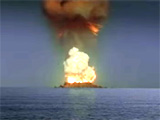 
|
||||||||
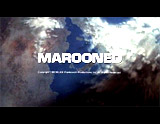
|
Marooned (1969) Marooned was the first astronauts-in-danger stranded-in-space film, and was based upon Martin Caidin's 1964 novel of the same name. Director John Sturges' disaster-in-space film from Columbia Pictures was nominated for three Academy Awards (including Best Cinematography and Best Sound), and won the Best Special Visual Effects Oscar. However, it was a major box-office flop due to its lack of action and poor pacing issues. It told about three astronauts whose rockets refused to ignite ("negative retrofire") in order to return to Earth. It was notable in that the film followed shortly after the real-life, successful Apollo 11 moon-landing (in mid-July 1969). It was also prophetic in regards to the disastrous voyage of the Apollo 13 mission two years later. The astronauts who faced dangerous conditions due to dwindling oxygen and became marooned in orbit were:
Commander Pruett sacrificed his life (was it intentional or not?) during a spacewalk when he suffered a fatal tear in his spacesuit, making it possible that the other two would live. After abandoning their Ironman One spaceship during a rescue mission, the two surviving crewmembers were returned to Earth. |

|
||||||||